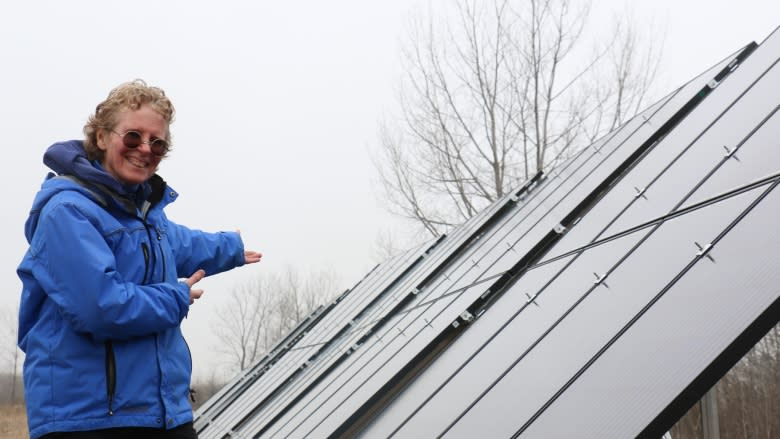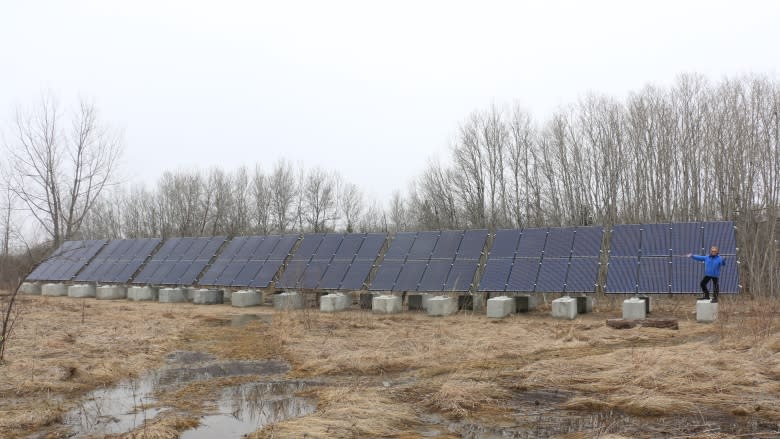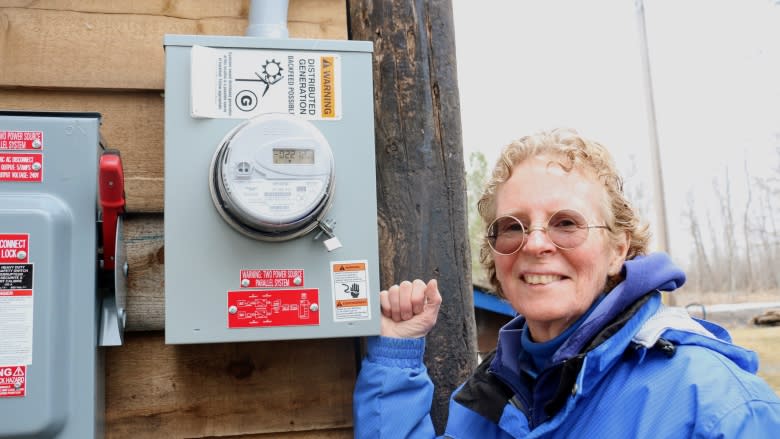Manitoban shines light on solar energy with $1.83 hydro bill
When Heather Bishop looks at the long row of solar panels installed in the yard of her rural southern Manitoba home, she sees not only an impressive setup, but an investment in the future.
"Every time I drive into the yard, it catches me again, and it's like, 'Wow! That's impressive,'" Bishop said.
The 64 solar panels are about 34 metres long and four metres high. On a really sunny day, they make a light buzzing sound and you can feel their vibrations if you put your hand on them, she said.
Walking through the melting snow on her property, the folk singer and artist said when a Manitoba Hydro program made solar panels affordable, she knew she wanted to jump on it right away.
"It's a renewable energy source — no harm to the environment while it's producing it — and if I can be part of that, I want to be part of it," Bishop said.
Power Smart
Last April, Manitoba Hydro launched the Power Smart Solar Energy Program to help Manitobans harness the power of the sun.
It offers incentives and financial support for people to adopt solar power to generate their own electricity and sell the excess energy back to Manitoba Hydro. The program provides solar photovoltaic installations at $1 per watt installed, which covers about 25 per cent of the costs of a new installation.
Hydro spokesperson Bruce Owen confirmed 38 of 180 applications to the program have been approved so far. Most have been from residential customers, with an even split coming from urban and rural property owners.
"Approximately half of the customers who've applied are also applying for financing of their system through Manitoba Hydro's convenient residential earth power loan program, which provides up to $30,000 for solar photovoltaic panels," Owen said in a statement, adding financing is calculated based on $3,000 per kilowatt of panels installed.
The average seven-kilowatt systems being installed contain 28 solar panels, take up more than 400 square feet of roof space and generate roughly 75 per cent of a home's annual electricity, Owen added.
Forward-looking
When Bishop built her house more than 40 years ago, she had alternative energy in the plans. It operated on passive solar energy, which means the way the house is built actually helps heat the home.
"At that time, I could heat my house with the sun, but I'm still using electricity from Manitoba Hydro," she said.
"I'm watching for the cost of panels and inverters to come down and then a year ago, Manitoba Hydro came up with this program where they would pay for basically almost a third of the cost of the install. As soon as I saw that, I contacted them right away."
The whole setup cost about $58,000, which meant Bishop's part of the bill was about $40,000, she said. She figures her annual hydro cost was $2,000, so it will be paid back in 20 years, but "as soon as hydro goes up, that figure drops and drops."
The solar panels were ready to go in January and, even though it was winter, Bishop said she produced more electricity than she needed.
"I just got my last Hydro bill for January and it was $1.83. The only reason I had to pay anything was because I have to pay the taxes on what I use but I don't get paid taxes on what I sent them," she said.
"So I actually sent them more power than I used, but I got dinged for taxes, so I owed them $1.83 and I can live with that."
Bishop understands it's a big investment for people in Manitoba, but when they look at their own energy bills and the cost to the planet, it's worth it, she said.
"I'm hugely connected to the earth and I feel a great responsibility to take care of her as much as I'm able," she said.




